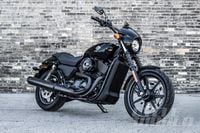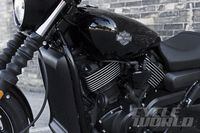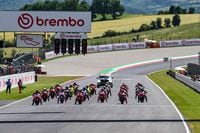There seems to be some confusion online about where the new Harley-Davidson Street 750 and Street 500 models are going to be built. Perhaps because these small, liquid-cooled bikes (priced at $7,500 and $6,700, respectively) will become the entry-level Harleys when they arrive in the second quarter of 2014, more than a few people on our website have speculated that these first all-new HDs in 13 years will be built in the company's Bawal, India, plant, the complete knock-down (CKD) facility that has been assembling bikes since 2011.
That’s partially true. But let’s be perfectly clear: All Street 750s and Street 500s for US and Canadian consumption will be built in the Harley-Davidson Vehicle and Powertrain Operations plant in Kansas City, Missouri, where there is a manufacturing line dedicated to producing the liquid-cooled Revolution X engine, a new 60-degree V-twin featuring chain-driven single overhead camshafts. On the other hand, all Street 750s and Street 500s for India, Italy, Spain, and Portugal (the only other markets at this time), will be built in Bawal, which has been expanded to a full manufacturing plant (for the Street models only) and uses parts sourced from all over the world.
Of note, the Revolution X engines and six-speed transmissions for the non US and Canadian models are also built in Bawal, on an expanded manufacturing line there. By producing bikes in India—as it has done since 2011 with models such as the SuperLow, Iron, 48, Street Bob, Fat Bob, Super Glide Custom, Fat Boy, Fat Boy Special, and Heritage Softail Classic—Harley avoids steep import tariffs, which has helped The Motor Company acquire a lion’s share of the heavyweight market in the world’s second most populous nation.
Harley-Davidson, in a move that helps make clear the manufacturing location of its new Street models, invited its North American dealers to Kansas City this month to see for themselves that the bikes for US and Canadian consumption are being built right here in the U.S. Incidentally, Harley-Davidson says that U.S.- and Indian-built Street models are identical to one another, each even having the same headlights and directional signals that are said to be legal in all markets worldwide. The only exception? Indian models require a special “saree guard” on the rear wheel because so many passengers there ride sidesaddle. That’s probably not a concern in Dubuque, Des Moines, or Dallas.


/cloudfront-us-east-1.images.arcpublishing.com/octane/NZKPFUWBHVGYJAFQPCXWAK6BZM.jpg)
/cloudfront-us-east-1.images.arcpublishing.com/octane/K5ZSQFMYQZHWRFXTTW4PEWMUDM.jpg)
/cloudfront-us-east-1.images.arcpublishing.com/octane/D2SOSBIQQRBPTERNSOJRAW3KYY.jpg)
/cloudfront-us-east-1.images.arcpublishing.com/octane/DS3Q5X2VJFFAJDK2PWB3Y7K6U4.jpg)
/cloudfront-us-east-1.images.arcpublishing.com/octane/4KBL4JAMYRFDPEINTWATDUH7OM.jpg)
/cloudfront-us-east-1.images.arcpublishing.com/octane/FXADK3MVSNBRTKJ2B7TPDCCJ5Y.jpg)
/cloudfront-us-east-1.images.arcpublishing.com/octane/M7L2CPXO55FRFMECW7QGDPGP6E.jpg)
/cloudfront-us-east-1.images.arcpublishing.com/octane/T4RWGLAEHVE2VCJZOTFTNGB2KA.jpg)
/cloudfront-us-east-1.images.arcpublishing.com/octane/JM4QGLAHWNGHPM74OEB7FVBFSY.jpg)
/cloudfront-us-east-1.images.arcpublishing.com/octane/BGPNXPDDYBHD3HL6YEZQOYHXTI.jpg)
/cloudfront-us-east-1.images.arcpublishing.com/octane/SND5GGQV4RDPPMZBSBEGIZ4SIY.jpg)
/cloudfront-us-east-1.images.arcpublishing.com/octane/XUDDAPYZMZEL5EDPVDJ2DTULWI.jpg)
/cloudfront-us-east-1.images.arcpublishing.com/octane/M7AU2L6GAVCJVHW57LIRPDAAUQ.jpg)

/cloudfront-us-east-1.images.arcpublishing.com/octane/JKEJY7P43JGD5C5NJO2VJQJPUM.jpg)
/cloudfront-us-east-1.images.arcpublishing.com/octane/YROKYJYUQVGPHCEMPTGBWDQCKQ.jpg)
/cloudfront-us-east-1.images.arcpublishing.com/octane/QIHEYR66TZDAPCGMWHCWCBC4XA.jpg)
/cloudfront-us-east-1.images.arcpublishing.com/octane/4FTBMNZL5BD2ZHY62XXRHJW6PI.jpg)
/cloudfront-us-east-1.images.arcpublishing.com/octane/L2BHKRCEMFDF7O3S4REZXPDH2E.jpg)
/cloudfront-us-east-1.images.arcpublishing.com/octane/QHENIV3HMJCTTCXQ6O5YPTNRZ4.jpg)
/cloudfront-us-east-1.images.arcpublishing.com/octane/K3VNQBIAKVGIHIGBRG7QKJYLVI.jpg)
/cloudfront-us-east-1.images.arcpublishing.com/octane/HRU64QXT3NH2DJOFBVI53XIKCE.jpg)
/cloudfront-us-east-1.images.arcpublishing.com/octane/4C5HHSNJCVDZXPIJTCJBVTE2MU.jpg)
/cloudfront-us-east-1.images.arcpublishing.com/octane/HBKK2TCOCZFIBIVKLKZFF5NXLQ.jpg)